习俗文化与翻译
中国传统文化汉英翻译
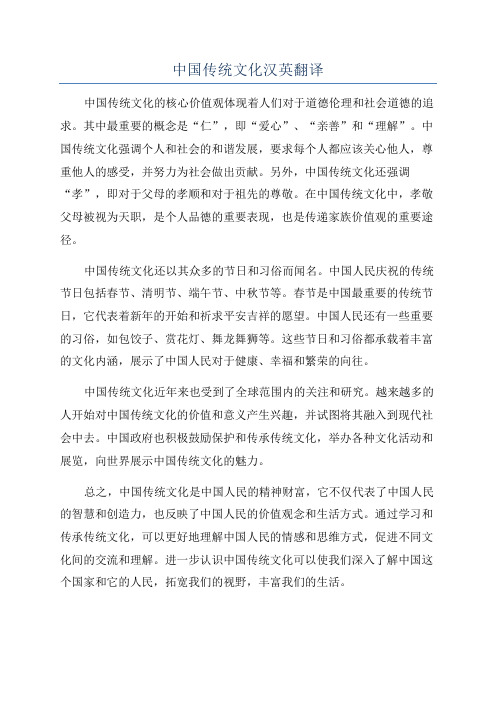
中国传统文化汉英翻译
中国传统文化的核心价值观体现着人们对于道德伦理和社会道德的追求。
其中最重要的概念是“仁”,即“爱心”、“亲善”和“理解”。
中国传统文化强调个人和社会的和谐发展,要求每个人都应该关心他人,尊重他人的感受,并努力为社会做出贡献。
另外,中国传统文化还强调“孝”,即对于父母的孝顺和对于祖先的尊敬。
在中国传统文化中,孝敬父母被视为天职,是个人品德的重要表现,也是传递家族价值观的重要途径。
中国传统文化还以其众多的节日和习俗而闻名。
中国人民庆祝的传统节日包括春节、清明节、端午节、中秋节等。
春节是中国最重要的传统节日,它代表着新年的开始和祈求平安吉祥的愿望。
中国人民还有一些重要的习俗,如包饺子、赏花灯、舞龙舞狮等。
这些节日和习俗都承载着丰富的文化内涵,展示了中国人民对于健康、幸福和繁荣的向往。
中国传统文化近年来也受到了全球范围内的关注和研究。
越来越多的人开始对中国传统文化的价值和意义产生兴趣,并试图将其融入到现代社会中去。
中国政府也积极鼓励保护和传承传统文化,举办各种文化活动和展览,向世界展示中国传统文化的魅力。
总之,中国传统文化是中国人民的精神财富,它不仅代表了中国人民的智慧和创造力,也反映了中国人民的价值观念和生活方式。
通过学习和传承传统文化,可以更好地理解中国人民的情感和思维方式,促进不同文化间的交流和理解。
进一步认识中国传统文化可以使我们深入了解中国这个国家和它的人民,拓宽我们的视野,丰富我们的生活。
春节习俗英文版带翻译

Family Reunion (团圆)
One of the most important aspects of Chinese New Year is the reunion of family members. Many people travel long distancesto be with their loved ones during this special time. The tradition of family reunion represents the importance of maintaining close relationships and honoring familial ties.
在中国新年期间,人们会放烟花和爆竹来驱赶邪灵,带来好运。巨大的声响和明亮的灯光也被认为能够迎接新的一年,营造节日气氛。
Lucky Money (压岁钱)
Children receive lucky money in red envelopes from their elders as a symbol of good fortune and blessings for the new year. It is a way of passing on good wishes and blessings to the younger generation.
Chinese New Year, also known as the Spring Festival, is the most important and widely celebrated holiday in China. It is a time for families to come together, honor their ancestors, and welcome the arrival of the new year. The festival is rich in traditions and customs that have been passed down through generations. In this article, we will explore some of the most popular Chinese New Year customs and their significance.
中国文化习俗段落翻译

中国文化习俗段落翻译1. 中西方饮食习惯(eating habits)存在极大差异。
不同于西方那种每人一盘食物的饮食习惯,在中国,菜肴是被放在桌上让大家共同分享的。
如果你在中国主人家做客,就要做好有一大桌食物的心理准备。
中国人对于自己的烹饪文化(culture of cuisine)感到非常自豪,而且会尽全力去展示自己的好客(hospitality)。
而且有时候,中国主人会用他们的筷子把食物夹到你的碗里或盘子中。
这是礼貌的体现。
2. 在中国,小孩的满月酒(One-Month-Old Feast)和抓周(One-Year-Old Catch)仪式独具特色。
小孩出生满一个月的那天,孩子的家人一般要招呼亲朋挚友,邀请他们一起来庆祝孩子满月。
小孩儿慢周岁的那天,有抓周到额仪式。
按照中国的传统,父母及他人不给予任何的引导和暗示,任孩子随意挑选,看他先抓什么后抓什么,并以此为依据来预测孩子可能存在的志趣和将从事的职业以及前途。
参考译文1.There are great differences between Chinese and Western eating habits. Unlike the West, where everyone has their own plate of food, in China the dishes are placed on the table and everybody shares. If you are being treated by a Chinese host, be prepared for a table of food. Chinese are very proud of their culture of cuisine and will do their best to show their hospitality. And sometimes the Chinese hosts use their chopsticks to put food in your bowl or plate. This is a sign of politeness.参考译文2: In China, One-Month-Old Feast and One-Year-Old Catch of a baby are of unique Chinese characteristics. On the day when a baby is a month old, the family of the baby will invite their friends and relatives to a ceremony to celebrate the occasion. On the day when a baby is one year old, there is a ceremony of One-Year-Old Catch. According to Chinese traditional custom, nobody will give any instruction or clue to the baby so that it is left free to choose by itself. Watching the baby catch the articles it likes, the family can then make predictions about its potential interest, future career and development.春节贴年画(pasting New Year Print s)的风俗源自于往房子外面的门上贴门神(Door Gods)的传统,随着木质雕刻品(board carvings)的出现,年画包含了更广泛地主题,最出名的就是门神,三大神——福神、薪神、和兽神(three Gods of Blessings, Salary and Longevity),寓意着庄稼丰收、家畜兴旺和庆祝春节。
习俗文化作文英语模板
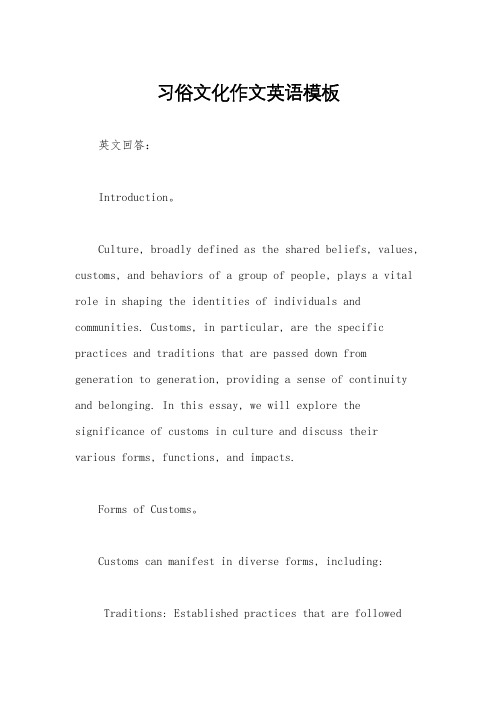
习俗文化作文英语模板英文回答:Introduction。
Culture, broadly defined as the shared beliefs, values, customs, and behaviors of a group of people, plays a vital role in shaping the identities of individuals and communities. Customs, in particular, are the specific practices and traditions that are passed down from generation to generation, providing a sense of continuity and belonging. In this essay, we will explore the significance of customs in culture and discuss their various forms, functions, and impacts.Forms of Customs。
Customs can manifest in diverse forms, including:Traditions: Established practices that are followedover time, such as religious ceremonies, marriage customs, and holiday celebrations.Rituals: Formalized sequences of actions performed for specific purposes, such as initiations, funerals, and healing rituals.Habits: Repetitive behaviors that have become ingrained, such as daily routines, dietary practices, and language patterns.Norms: Unwritten rules that govern behavior and expectations within a society, such as social etiquette, dress codes, and gender roles.Functions of Customs。
中国传统文化英语翻译
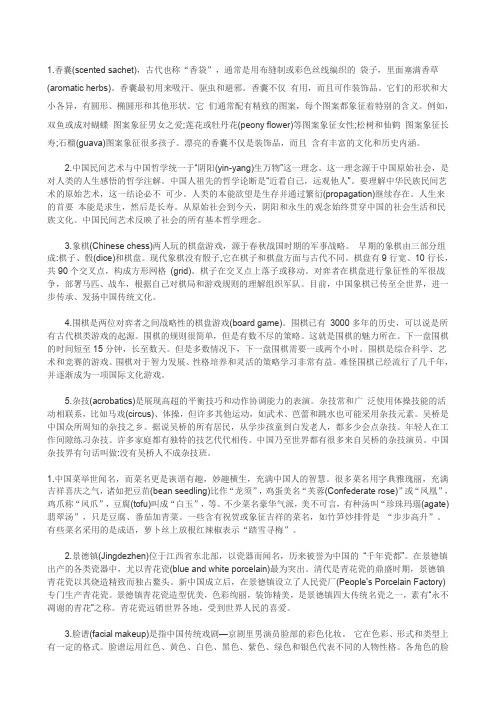
1.香囊(scented sachet),古代也称“香袋”,通常是用布缝制或彩色丝线编织的袋子,里面塞满香草(aromatic herbs)。
香囊最初用来吸汗、驱虫和避邪。
香囊不仅有用,而且可作装饰品。
它们的形状和大小各异,有圆形、椭圆形和其他形状。
它们通常配有精致的图案,每个图案都象征着特别的含义。
例如,双鱼或成对蝴蝶图案象征男女之爱;莲花或牡丹花(peony flower)等图案象征女性;松树和仙鹤图案象征长寿;石榴(guava)图案象征很多孩子。
漂亮的香囊不仅是装饰品,而且含有丰富的文化和历史内涵。
2.中国民间艺术与中国哲学统一于“阴阳(yin-yang)生万物”这一理念。
这一理念源于中国原始社会,是对人类的人生感悟的哲学注解。
中国人祖先的哲学论断是“近看自己,远观他人”。
要理解中华民族民间艺术的原始艺术,这一结论必不可少。
人类的本能欲望是生存并通过繁衍(propagation)继续存在。
人生来的首要本能是求生,然后是长寿。
从原始社会到今天,阴阳和永生的观念始终贯穿中国的社会生活和民族文化。
中国民间艺术反映了社会的所有基本哲学理念。
3.象棋(Chinese chess)两人玩的棋盘游戏,源于春秋战国时期的军事战略。
早期的象棋由三部分组成:棋子、骰(dice)和棋盘。
现代象棋没有骰子,它在棋子和棋盘方面与古代不同。
棋盘有9行宽、10行长,共90个交叉点,构成方形网格(grid)。
棋子在交叉点上落子或移动。
对弈者在棋盘进行象征性的军很战争,部署马匹、战车,根据自己对棋局和游戏规则的理解组织军队。
目前,中国象棋已传至全世界,进一步传承、发扬中国传统文化。
4.围棋是两位对弈者之间战略性的棋盘游戏(board game)。
围棋已有3000多年的历史,可以说是所有古代棋类游戏的起源。
围棋的规则很简单,但是有数不尽的策略。
这就是围棋的魅力所在。
下一盘围棋的时间短至15分钟,长至数天。
但是多数情况下,下一盘围棋需要一或两个小时。
中国传统文化翻译解读
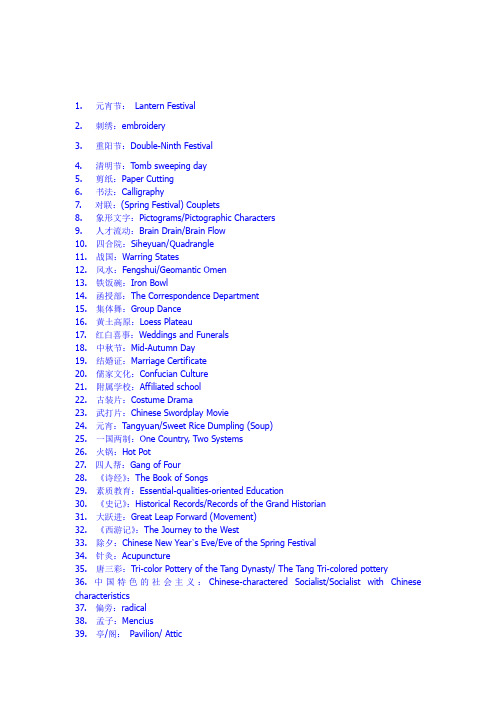
1. 元宵节:Lantern Festival2. 刺绣:embroidery3. 重阳节:Double-Ninth Festival4. 清明节:Tomb sweeping day5. 剪纸:Paper Cutting6. 书法:Calligraphy7. 对联:(Spring Festival) Couplets8. 象形文字:Pictograms/Pictographic Characters9. 人才流动:Brain Drain/Brain Flow10. 四合院:Siheyuan/Quadrangle11. 战国:Warring States12. 风水:Fengshui/Geomantic Omen13. 铁饭碗:Iron Bowl14. 函授部:The Correspondence Department15. 集体舞:Group Dance16. 黄土高原:Loess Plateau17. 红白喜事:Weddings and Funerals18. 中秋节:Mid-Autumn Day19. 结婚证:Marriage Certificate20. 儒家文化:Confucian Culture21. 附属学校:Affiliated school22. 古装片:Costume Drama23. 武打片:Chinese Swordplay Movie24. 元宵:Tangyuan/Sweet Rice Dumpling (Soup)25. 一国两制:One Country, Two Systems26. 火锅:Hot Pot27. 四人帮:Gang of Four28. 《诗经》:The Book of Songs29. 素质教育:Essential-qualities-oriented Education30. 《史记》:Historical Records/Records of the Grand Historian31. 大跃进:Great Leap Forward (Movement)32. 《西游记》:The Journey to the West33. 除夕:Chinese New Year’s Eve/Eve of the Spring Festival34. 针灸:Acupuncture35. 唐三彩:Tri-color Pottery of the Tang Dynasty/ The Tang Tri-colored pottery36. 中国特色的社会主义:Chinese-charactered Socialist/Socialist with Chinese characteristics37. 偏旁:radical38. 孟子:Mencius39. 亭/阁:Pavilion/ Attic40. 大中型国有企业:Large and Medium-sized State-owned Enterprises41. 火药:gunpowder42. 农历:Lunar Calendar43. 印/玺:Seal/Stamp44. 物质精神文明建设:The Construction of Material Civilization and Spiritual Civilization45. 京剧:Beijing Opera/Peking Opera46. 秦腔:Crying of Qin People/Qin Opera47. 太极拳:Tai Chi48. 独生子女证:The Certificate of One-child49. 天坛:Altar of Heaven in Beijing50. 小吃摊:Snack Bar/Snack Stand51. 红双喜:Double Happiness52. 政治辅导员:Political Counselor/School Counselor53. 春卷:Spring Roll(s)54. 莲藕:Lotus Root55. 追星族:Star Struck56. 故宫博物院:The Palace Museum57. 相声:Cross-talk/Comic Dialogue58. 下岗:Lay off/Laid off59. 北京烤鸭:Beijing Roast Duck60. 高等自学考试:Self-taught Examination of Higher Education61. 烟花爆竹:fireworks and firecracker62. 敦煌莫高窟:Mogao Caves63. 电视小品:TV Sketch/TV Skit64. 香港澳门同胞:Compatriots from Hong Kong and Macao65. 文化大革命:Cultural Revolution66. 长江中下游地区:The Mid-low Reaches of Yangtze River67. 门当户对:Perfect Match/Exact Match68. 《水浒》:Water Margin/Outlaws of the Marsh69. 中外合资企业:Joint Ventures70. 文房四宝(笔墨纸砚):"The Four Treasure of the Study" "Brush, Inkstick, Paper, and Inkstone"71.兵马俑:cotta Warriors/ Terracotta Army72.旗袍:cheongsam要了解中国文化,就应该对中国的戏曲文化有所了解。
春联、祭祖、团圆饭…用英文怎么说?春节习俗这样表达才地道!
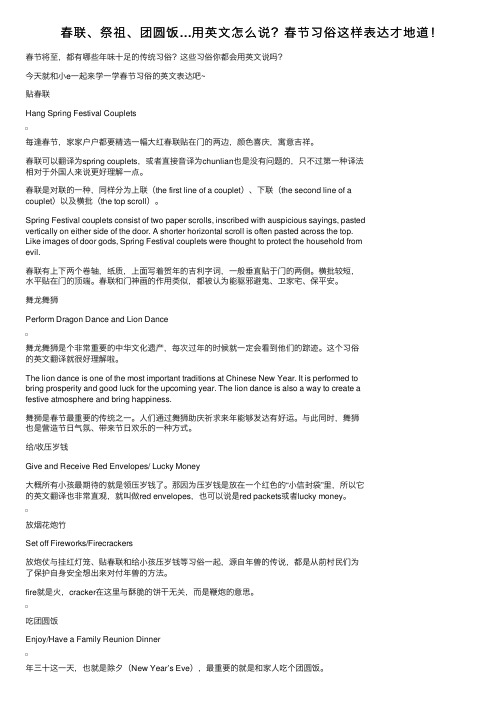
春联、祭祖、团圆饭…⽤英⽂怎么说?春节习俗这样表达才地道!春节将⾄,都有哪些年味⼗⾜的传统习俗?这些习俗你都会⽤英⽂说吗?今天就和⼩e⼀起来学⼀学春节习俗的英⽂表达吧~贴春联Hang Spring Festival Couplets每逢春节,家家户户都要精选⼀幅⼤红春联贴在门的两边,颜⾊喜庆,寓意吉祥。
春联可以翻译为spring couplets,或者直接⾳译为chunlian也是没有问题的,只不过第⼀种译法相对于外国⼈来说更好理解⼀点。
春联是对联的⼀种,同样分为上联(the first line of a couplet)、下联(the second line of acouplet)以及横批(the top scroll)。
Spring Festival couplets consist of two paper scrolls, inscribed with auspicious sayings, pastedvertically on either side of the door. A shorter horizontal scroll is often pasted across the top.Like images of door gods, Spring Festival couplets were thought to protect the household fromevil.春联有上下两个卷轴,纸质,上⾯写着贺年的吉利字词,⼀般垂直贴于门的两侧。
横批较短,⽔平贴在门的顶端。
春联和门神画的作⽤类似,都被认为能驱邪避⿁、卫家宅、保平安。
舞龙舞狮Perform Dragon Dance and Lion Dance舞龙舞狮是个⾮常重要的中华⽂化遗产,每次过年的时候就⼀定会看到他们的踪迹。
这个习俗的英⽂翻译就很好理解啦。
The lion dance is one of the most important traditions at Chinese New Year. It is performed tobring prosperity and good luck for the upcoming year. The lion dance is also a way to create afestive atmosphere and bring happiness.舞狮是春节最重要的传统之⼀。
2023年高中备考:传统文化英语作文带翻译(精选多篇)

2023年高中备考:传统文化英语作文带翻译(精选多篇)1. 传统文化的重要性 Importance of Traditional Culture传统文化是代代相传的财富,它包括传统艺术、祭祀、戏剧、音乐、诗歌和绘画等。
这些文化遗产代表了一个国家丰富的历史和文化背景。
然而,在现代化的进程中,传统文化的价值被忽视了,人们更加追求新奇和时尚的事物。
但传统文化不仅仅是一些历史遗迹,而是具有锤炼品德,陶冶情操的功能。
对于我们而言,传统文化是一种独特的身份认同、历史记忆和精神寄托。
因此,我们应该保护和传承传统文化,同时,将其融入到现代生活中,让传统与现代相结合,促进文化的创新和传承。
Traditional culture is a treasure passed down from generation to generation, including traditional arts, ceremonies, dramas, music, poetry, and painting. These cultural heritages represent a country's rich history and cultural background. However, in the process of modernization, the value of traditional culture has been neglected, and people pursue more novelty and fashion. But traditionalculture is not just some historical relics, but has the function of tempering moral character and cultivating sentiment. For us, traditional culture is a unique identity recognition, historical memory, and spiritual sustenance. Therefore, we should protectand inherit traditional culture, while integrating it into modern life, combining tradition with modernity, promoting cultural innovation and inheritance.2. 中国国画 The Chinese Painting中国国画是一种源远流长的绘画形式,历史悠久,流传至今,代表着中国传统文化和美学的精髓。
传统文化作文以及翻译英文
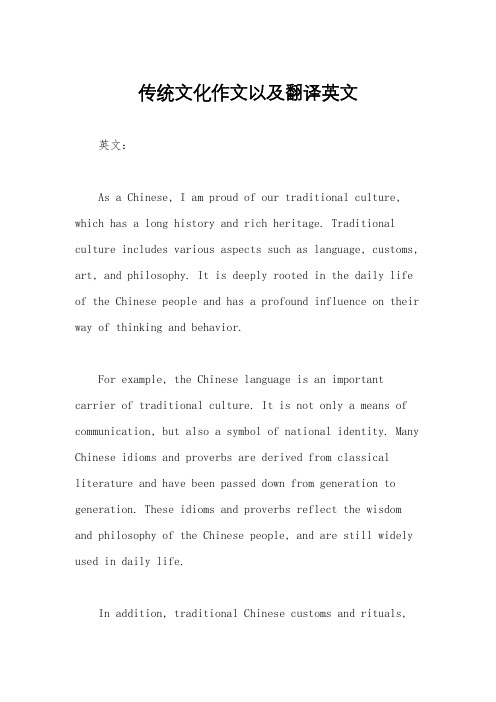
传统文化作文以及翻译英文英文:As a Chinese, I am proud of our traditional culture, which has a long history and rich heritage. Traditional culture includes various aspects such as language, customs, art, and philosophy. It is deeply rooted in the daily life of the Chinese people and has a profound influence on their way of thinking and behavior.For example, the Chinese language is an important carrier of traditional culture. It is not only a means of communication, but also a symbol of national identity. Many Chinese idioms and proverbs are derived from classical literature and have been passed down from generation to generation. These idioms and proverbs reflect the wisdom and philosophy of the Chinese people, and are still widely used in daily life.In addition, traditional Chinese customs and rituals,such as the Spring Festival, Qingming Festival, and Mid-Autumn Festival, are an integral part of traditional culture. These festivals are not only occasions for family reunions and gatherings, but also opportunities for people to express their respect for their ancestors and thenatural world. For example, during the Spring Festival, people will set off fireworks and hang red lanterns todrive away evil spirits and welcome the arrival of the new year.Furthermore, traditional Chinese art, such as calligraphy, painting, and opera, also embodies the essence of traditional culture. For instance, Chinese calligraphyis not only a form of artistic expression, but also a reflection of the Chinese people's pursuit of harmony and balance. The strokes and lines in calligraphy are imbued with profound meaning and convey the thoughts and emotions of the calligrapher.Overall, traditional culture plays a significant rolein shaping the values and beliefs of the Chinese people. It fosters a sense of belonging and identity, and provides aspiritual anchor in the fast-changing modern society.中文:作为一个中国人,我为我们的传统文化感到自豪,它有着悠久的历史和丰富的传承。
春节的习俗英语翻译

春节的习俗英语翻译春节的习俗英语翻译春节,是集除旧布新、拜神祭祖、祈福辟邪、亲朋团圆、欢庆娱乐和饮食为一体的民俗大节。
春节历史悠久,起源于早期人类的原始信仰与自然崇拜,由上古时代岁首祈岁祭祀演变而来,在传承发展中承载了丰厚的历史文化底蕴。
下面是小编帮大家整理的春节的习俗英语翻译,供大家参考借鉴,希望可以帮助到有需要的朋友。
春节的习俗英语翻译篇1过年禁忌New Year taboos首先一点就是语言上忌讳。
过年的时候像"死"、"失败"、"病"这样比较晦气的话不能说。
打破碗碟也是忌讳。
如果不小心打破了,在场的人必须以迅雷不及掩耳盗铃儿响叮当之势,说上两句吉祥的顺口溜,如"岁(碎)岁平安","打发(大发,发财之意)"等来弥补。
Words can reflect New Year taboos. People tend to, for example, avoid negative words, such as "failing", "dying", and "illness" during New Year’s celebrations. Breaking a dish is another taboo in some places, because it implies that you will not have a thing to eat.很多地方过年的时候不能扫地,或者扫地时只能往屋内扫,不能往屋外扫,因为这样会把"财气"扫出去。
春节期间也不能扔垃圾,因为同样有可能扔掉"财运"。
但是现在,这些禁忌不太适合今天的生活了。
People do not carry the garbage out or clean the house on New Year’s Day or for the rest of the Spring Festival holiday, for fear of sweeping away good luck.春节期间也忌讳剃头。
中国文化习俗段落翻译
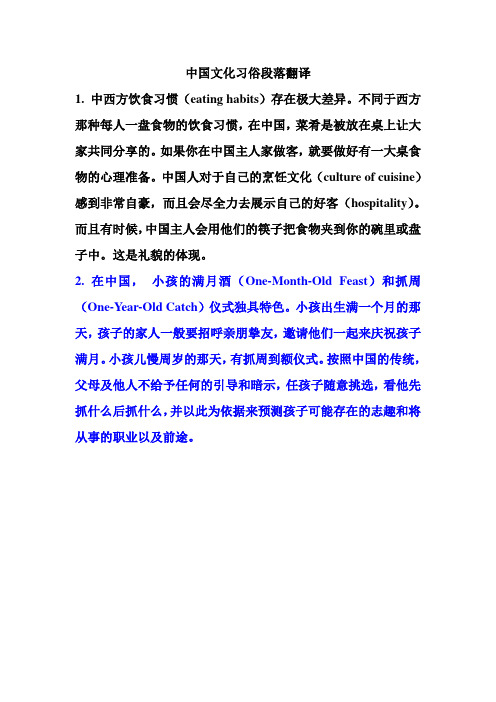
中国文化习俗段落翻译1. 中西方饮食习惯(eating habits)存在极大差异。
不同于西方那种每人一盘食物的饮食习惯,在中国,菜肴是被放在桌上让大家共同分享的。
如果你在中国主人家做客,就要做好有一大桌食物的心理准备。
中国人对于自己的烹饪文化(culture of cuisine)感到非常自豪,而且会尽全力去展示自己的好客(hospitality)。
而且有时候,中国主人会用他们的筷子把食物夹到你的碗里或盘子中。
这是礼貌的体现。
2. 在中国,小孩的满月酒(One-Month-Old Feast)和抓周(One-Year-Old Catch)仪式独具特色。
小孩出生满一个月的那天,孩子的家人一般要招呼亲朋挚友,邀请他们一起来庆祝孩子满月。
小孩儿慢周岁的那天,有抓周到额仪式。
按照中国的传统,父母及他人不给予任何的引导和暗示,任孩子随意挑选,看他先抓什么后抓什么,并以此为依据来预测孩子可能存在的志趣和将从事的职业以及前途。
参考译文1.There are great differences between Chinese and Western eating habits. Unlike the West, where everyone has their own plate of food, in China the dishes are placed on the table and everybody shares. If you are being treated by a Chinese host, be prepared for a table of food. Chinese are very proud of their culture of cuisine and will do their best to show their hospitality. And sometimes the Chinese hosts use their chopsticks to put food in your bowl or plate. This is a sign of politeness.参考译文2: In China, One-Month-Old Feast and One-Year-Old Catch of a baby are of unique Chinese characteristics. On the day when a baby is a month old, the family of the baby will invite their friends and relatives to a ceremony to celebrate the occasion. On the day when a baby is one year old, there is a ceremony of One-Year-Old Catch. According to Chinese traditional custom, nobody will give any instruction or clue to the baby so that it is left free to choose by itself. Watching the baby catch the articles it likes, the family can then make predictions about its potential interest, future career and development.春节贴年画(pasting New Year Print s)的风俗源自于往房子外面的门上贴门神(Door Gods)的传统,随着木质雕刻品(board carvings)的出现,年画包含了更广泛地主题,最出名的就是门神,三大神——福神、薪神、和兽神(three Gods of Blessings, Salary and Longevity),寓意着庄稼丰收、家畜兴旺和庆祝春节。
中国传统文化 翻译
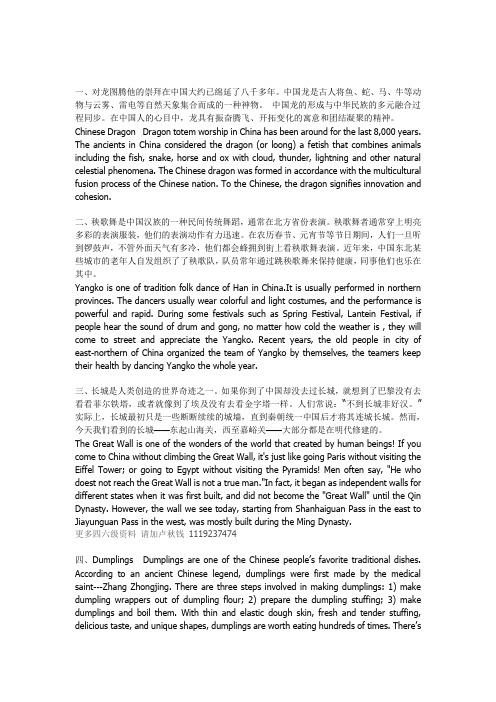
一、对龙图腾他的崇拜在中国大约已绵延了八千多年。
中国龙是古人将鱼、蛇、马、牛等动物与云雾、雷电等自然天象集合而成的一种神物。
中国龙的形成与中华民族的多元融合过程同步。
在中国人的心目中,龙具有振奋腾飞、开拓变化的寓意和团结凝聚的精神。
Chinese Dragon Dragon totem worship in China has been around for the last 8,000 years. The ancients in China considered the dragon (or loong) a fetish that combines animals including the fish, snake, horse and ox with cloud, thunder, lightning and other natural celestial phenomena. The Chinese dragon was formed in accordance with the multicultural fusion process of the Chinese nation. To the Chinese, the dragon signifies innovation and cohesion.二、秧歌舞是中国汉族的一种民间传统舞蹈,通常在北方省份表演。
秧歌舞者通常穿上明亮多彩的表演服装,他们的表演动作有力迅速。
在农历春节、元宵节等节日期间,人们一旦听到锣鼓声,不管外面天气有多冷,他们都会蜂拥到街上看秧歌舞表演。
近年来,中国东北某些城市的老年人自发组织了了秧歌队,队员常年通过跳秧歌舞来保持健康,同事他们也乐在其中。
Yangko is one of tradition folk dance of Han in China.It is usually performed in northern provinces. The dancers usually wear colorful and light costumes, and the performance is powerful and rapid. During some festivals such as Spring Festival, Lantein Festival, if people hear the sound of drum and gong, no matter how cold the weather is , they will come to street and appreciate the Yangko. Recent years, the old people in city of east-northern of China organized the team of Yangko by themselves, the teamers keep their health by dancing Yangko the whole year.三、长城是人类创造的世界奇迹之一。
中国传统文化(中英文)

中国传统文化一、“传统节日”单词预热vocabulary work烹调cooking cuisine鱼肉满架well stocked with fish and meat象征意义symbolic significance农历lunar calendar阳历solar calendar端午节Dragon Boat Festival元宵节Lantern Festival清明节Pure Brightness Day重阳节Double Ninth Day放逐be exiled忠臣loyal minister糯米粽子glutinous rice dumplings wrapped in bamboo leaves 祭祀亡灵in memory of sb.龙舟比赛dragon boat races中秋节Mid Autumn Festival满月full moon月饼moon cake蜜饯preserved fruits豆沙bean paste蛋黄egg yolk海鲜seafood家禽poultry饺子dumplings八宝饭eight treasure rice米羹rice balls油条fried sticks麻花fried twisted stick炒面Chaomian叉烧包steamed bun with roast pork粥porridge芋头taro葱油饼pan-fried cake with sesame seeds and green onion有关春节的常用词放鞭炮let off firecrackers耍龙灯play the dragon lantern耍狮子play the lion dance拜年pay a new-year call二、有关“介绍”的翻译•我很高兴向各位介绍中国的主要传统节日。
→I am very happy to have the opportunity to talk to you about major traditional Chinese holidays.表示“介绍情况”时,我们可以这样翻译:1.to share with you brief information•在此,我愿意向朋友们介绍这些方面的情况。
传统文化英语作文带中文翻译

传统文化英语作文带中文翻译In today's fast-paced and ever-changing world, it is easy to overlook the value and importance of traditional culture. However, traditional culture is a precious heritage that carries the wisdom, beliefs, and values of our ancestors. It serves as a bridge between the past and the present, connecting us to our roots and shaping our identity.Traditional culture encompasses various aspects, including art, music, literature, customs, and rituals. These cultural elements reflect the unique traditions and heritage of a community or society, offering insights into their way of life, beliefs, and values.By embracing traditional culture, we gain a deeper appreciation for our heritage and history. We learn about the struggles, triumphs, and experiences of those who came before us, gaining a sense of connection and continuity across generations.Moreover, traditional culture provides a sense of belonging and community. It fosters unity and solidarity among individuals who share common traditions and customs,creating a sense of identity and pride in one's cultural heritage.In a rapidly changing world, preserving and promoting traditional culture is essential to maintaining cultural diversity and preserving our collective memory. By celebrating and honoring our traditional culture, we ensure that future generations can continue to learn from and be inspired by the rich tapestry of our cultural heritage.中文翻译:在当今快节奏和不断变化的世界里,很容易忽视传统文化的价值和重要性。
传统文化英语作文带翻译80词
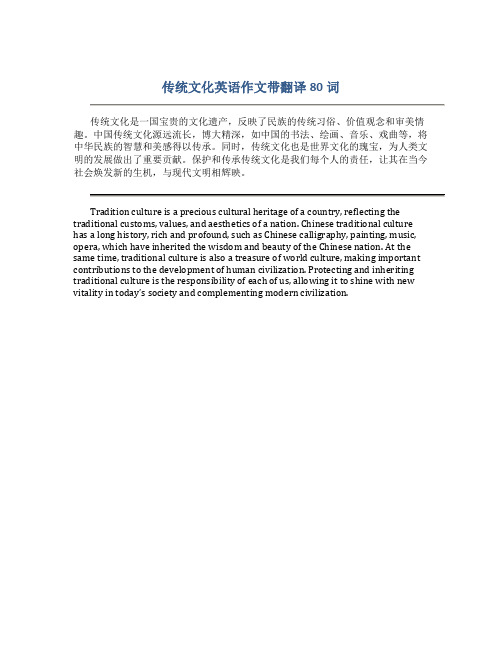
传统文化英语作文带翻译80词传统文化是一国宝贵的文化遗产,反映了民族的传统习俗、价值观念和审美情趣。
中国传统文化源远流长,博大精深,如中国的书法、绘画、音乐、戏曲等,将中华民族的智慧和美感得以传承。
同时,传统文化也是世界文化的瑰宝,为人类文明的发展做出了重要贡献。
保护和传承传统文化是我们每个人的责任,让其在当今社会焕发新的生机,与现代文明相辉映。
Tradition culture is a precious cultural heritage of a country, reflecting the traditional customs, values, and aesthetics of a nation. Chinese traditional culture has a long history, rich and profound, such as Chinese calligraphy, painting, music, opera, which have inherited the wisdom and beauty of the Chinese nation. At the same time, traditional culture is also a treasure of world culture, making important contributions to the development of human civilization. Protecting and inheriting traditional culture is the responsibility of each of us, allowing it to shine with new vitality in today’s society and complementing modern civilization.。
四六级中国文化翻译 2
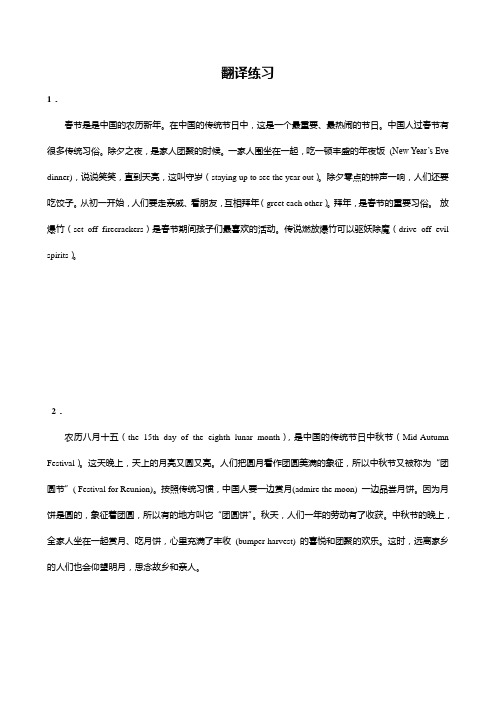
翻译练习1.春节是是中国的农历新年。
在中国的传统节日中,这是一个最重要、最热闹的节日。
中国人过春节有很多传统习俗。
除夕之夜,是家人团聚的时候。
一家人围坐在一起,吃一顿丰盛的年夜饭(New Year’s Eve dinner),说说笑笑,直到天亮,这叫守岁(staying up to see the year out)。
除夕零点的钟声一响,人们还要吃饺子。
从初一开始,人们要走亲戚、看朋友,互相拜年(greet each other)。
拜年,是春节的重要习俗。
放爆竹(set off firecrackers)是春节期间孩子们最喜欢的活动。
传说燃放爆竹可以驱妖除魔(drive off evil spirits)。
2.农历八月十五(the 15th day of the eighth lunar month),是中国的传统节日中秋节(Mid-Autumn Festival)。
这天晚上,天上的月亮又圆又亮。
人们把圆月看作团圆美满的象征,所以中秋节又被称为“团圆节”( Festival for Reunion)。
按照传统习惯,中国人要一边赏月(admire the moon) 一边品尝月饼。
因为月饼是圆的,象征着团圆,所以有的地方叫它“团圆饼”。
秋天,人们一年的劳动有了收获。
中秋节的晚上,全家人坐在一起赏月、吃月饼,心里充满了丰收(bumper harvest) 的喜悦和团聚的欢乐。
这时,远离家乡的人们也会仰望明月,思念故乡和亲人。
3.英语中的“china”一词有两个意义,一个是中国,一个是瓷(porcelain)。
西方人很早就把中国与瓷器联系在一起,这是因为瓷器是中国人发明的。
瓷器是从陶器(pottery) 发展来的,如果从生产原始瓷器的商代(Shang Dynasty)算起,中国的瓷器大约有三千多年的历史了。
江西景德镇被称为中国的“瓷都”(the Capital of Porcelain)。
中国瓷器不仅是精美的日用品,也是珍贵的艺术品。
中国春节民俗文化及汉英翻译方法探析
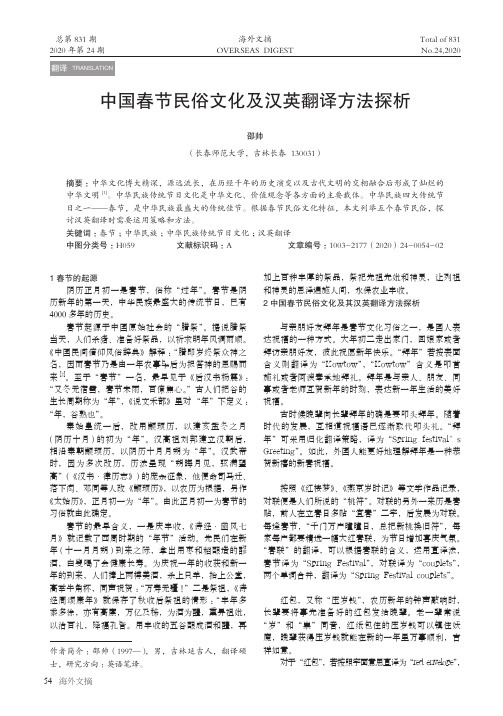
54海外文摘OVERSEAS DIGEST 海外文摘2020年第24期总第831期No.24,2020Total of 8311春节的起源阴历正月初一是春节,俗称“过年”。
春节是阴历新年的第一天,中华民族最盛大的传统节日,已有4000多年的历史。
春节起源于中国原始社会的“腊祭”。
据说腊祭当天,人们杀猪、准备好祭品,以祈求明年风调雨顺。
《中国民间信仰风俗辞典》解释:“腊即岁终祭众神之名,因而春节乃是由一年农事毕后为报答神的恩赐而来[2]。
至于“春节”一名,最早见于《后汉书杨震》:“又冬无宿雪,春节未雨,百僚焦心。
”古人们把谷的生长周期称为“年”,《说文禾部》里对 “年”下定义:“年,谷熟也”。
秦始皇统一后,改用颛顼历,以建亥孟冬之月(阴历十月)的初为“年”。
汉高祖刘邦建立汉朝后,相沿秦朝颛顼历,以阴历十月月朔为“年”。
汉武帝时,因为多次改历,历法呈现“朔晦月见,弦满望高”(《汉书·律历志》)的庞杂征象,他便命司马迁、落下闳、邓同等人改《颛顼历》,以农历为根据,另作《太始历》,正月初一为“年”。
由此正月初一为春节的习俗就由此确定。
春节的最早含义,一是庆丰收,《诗经·豳风七月》就记载了西周时期的“年节”活动。
先民们在新年(十一月月朔)到来之际,拿出用枣和稻酿造的醪酒,白叟喝了会健康长寿。
为庆祝一年的收获和新一年的到来,人们捧上两樽美酒,杀上只羊,抬上公堂,高举牛角杯,同声祝贺:“万寿无疆!”二是祭祖,《诗经周颂康年》就保存了秋收后祭祖的情形:“丰年多黍多徐,亦有高廪,万亿及秭,为酒为醴,熏畀祖妣,以洽百礼,降福孔皆。
用丰收的五谷酿成酒和醴,再加上百种丰厚的祭品,祭祀先祖先妣和神灵,让列祖和神灵的恩泽遍施人间,永保农业丰收。
2中国春节民俗文化及其汉英翻译方法探析2.1拜年——Spring Festival’s Greeting与亲朋好友拜年是春节文化习俗之一,是国人表达祝福的一种方式。
高中英语 高考英语作文有关中国传统文化的范文5篇带中文翻译
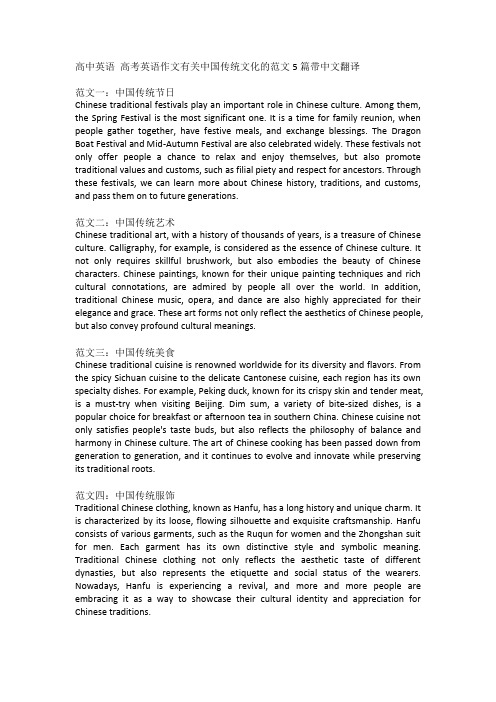
高中英语高考英语作文有关中国传统文化的范文5篇带中文翻译范文一:中国传统节日Chinese traditional festivals play an important role in Chinese culture. Among them, the Spring Festival is the most significant one. It is a time for family reunion, when people gather together, have festive meals, and exchange blessings. The Dragon Boat Festival and Mid-Autumn Festival are also celebrated widely. These festivals not only offer people a chance to relax and enjoy themselves, but also promote traditional values and customs, such as filial piety and respect for ancestors. Through these festivals, we can learn more about Chinese history, traditions, and customs, and pass them on to future generations.范文二:中国传统艺术Chinese traditional art, with a history of thousands of years, is a treasure of Chinese culture. Calligraphy, for example, is considered as the essence of Chinese culture. It not only requires skillful brushwork, but also embodies the beauty of Chinese characters. Chinese paintings, known for their unique painting techniques and rich cultural connotations, are admired by people all over the world. In addition, traditional Chinese music, opera, and dance are also highly appreciated for their elegance and grace. These art forms not only reflect the aesthetics of Chinese people, but also convey profound cultural meanings.范文三:中国传统美食Chinese traditional cuisine is renowned worldwide for its diversity and flavors. From the spicy Sichuan cuisine to the delicate Cantonese cuisine, each region has its own specialty dishes. For example, Peking duck, known for its crispy skin and tender meat, is a must-try when visiting Beijing. Dim sum, a variety of bite-sized dishes, is a popular choice for breakfast or afternoon tea in southern China. Chinese cuisine not only satisfies people's taste buds, but also reflects the philosophy of balance and harmony in Chinese culture. The art of Chinese cooking has been passed down from generation to generation, and it continues to evolve and innovate while preserving its traditional roots.范文四:中国传统服饰Traditional Chinese clothing, known as Hanfu, has a long history and unique charm. It is characterized by its loose, flowing silhouette and exquisite craftsmanship. Hanfu consists of various garments, such as the Ruqun for women and the Zhongshan suit for men. Each garment has its own distinctive style and symbolic meaning. Traditional Chinese clothing not only reflects the aesthetic taste of different dynasties, but also represents the etiquette and social status of the wearers. Nowadays, Hanfu is experiencing a revival, and more and more people are embracing it as a way to showcase their cultural identity and appreciation for Chinese traditions.范文五:中国传统建筑Chinese traditional architecture, with its distinctive style and profound cultural connotations, is a true representation of Chinese culture. The Forbidden City in Beijing, with its grandeur and meticulous design, is a masterpiece of traditional Chinese architecture. The classical gardens in Suzhou, known for their harmonious layout and exquisite details, showcase the perfect integration of nature and human creations. Traditional Chinese architecture also emphasizes the balance of Yin and Yang, and the harmony between man and nature. It is not only a manifestation of architectural skills, but also a reflection of the wisdom and philosophy of the Chinese people.范文一:中国传统节日中国传统节日在中国文化中占有重要地位。
春节的风俗英语加翻译

春节的风俗英语加翻译During the Spring Festival, there are several customs that are widely observed in China.1. 春联(chūn lián) - Spring coupletsSpring couplets are red banners with poetic verses written on them. They are hung on doorways to bring blessings and good luck for the coming year.2. 团圆饭 (tuán yuán fàn) - Reunion dinnerThe reunion dinner is the most important meal during the Spring Festival. Family members gather together to enjoy a feast and celebrate the beginning of the new year.3. 红包(hóng bāo) - Red envelopesRed envelopes filled with money are given as gifts during the Spring Festival. It is a symbol of good luck and blessings for the recipients.4. 烟花爆竹(yān huā bào zhú) - Fireworks and firecrackers Fireworks and firecrackers are lit during the Spring Festival to drive away evil spirits. It is believed that the loud noises can scare away any bad luck and bring prosperity for the new year.5. 拜年 (bài nián) - Say New Year greetingsDuring the Spring Festival, it is customary to visit friends and relatives to exchange New Year greetings and good wishes for the year ahead.6. 舞龙舞狮(wǔ lóng wǔ shī) - Dragon and lion danceDragon and lion dances are performed during the Spring Festival to bring good fortune and drive away evil spirits. Colorful dragon and lion costumes are worn by performers, who dance to the beat of drums and cymbals.7. 春节联欢晚会(chūn jié lián huān wǎn huì) - Spring Festival GalaThe Spring Festival Gala is a variety show broadcasted on TV annually during the Spring Festival. It features music, dance, comedy, and other performances to entertain people and celebrate the new year.8. 开门红(kāi mén hóng) - Open houseSome people hold open houses during the Spring Festival, where friends and relatives can drop by to visit and share New Year greetings. It is a way to strengthen social connections and maintain relationships.以上是中国春节时常见的风俗习俗。
清明节的习俗翻译
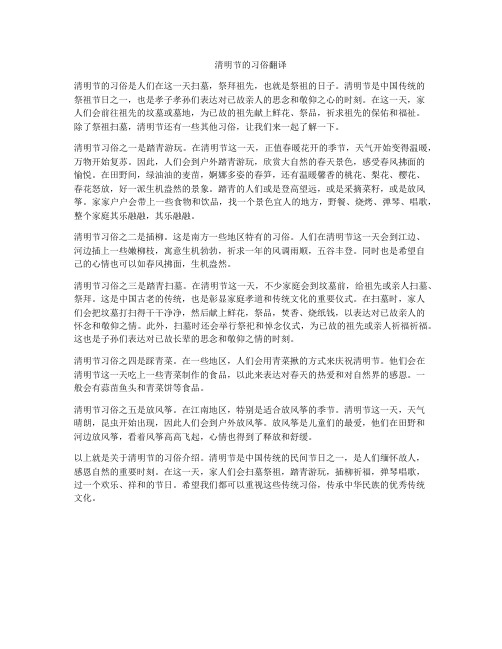
清明节的习俗翻译清明节的习俗是人们在这一天扫墓,祭拜祖先,也就是祭祖的日子。
清明节是中国传统的祭祖节日之一,也是孝子孝孙们表达对已故亲人的思念和敬仰之心的时刻。
在这一天,家人们会前往祖先的坟墓或墓地,为已故的祖先献上鲜花、祭品,祈求祖先的保佑和福祉。
除了祭祖扫墓,清明节还有一些其他习俗,让我们来一起了解一下。
清明节习俗之一是踏青游玩。
在清明节这一天,正值春暖花开的季节,天气开始变得温暖,万物开始复苏。
因此,人们会到户外踏青游玩,欣赏大自然的春天景色,感受春风拂面的愉悦。
在田野间,绿油油的麦苗,婀娜多姿的春笋,还有温暖馨香的桃花、梨花、樱花、春花怒放,好一派生机盎然的景象。
踏青的人们或是登高望远,或是采摘菜籽,或是放风筝。
家家户户会带上一些食物和饮品,找一个景色宜人的地方,野餐、烧烤、弹琴、唱歌,整个家庭其乐融融,其乐融融。
清明节习俗之二是插柳。
这是南方一些地区特有的习俗。
人们在清明节这一天会到江边、河边插上一些嫩柳枝,寓意生机勃勃,祈求一年的风调雨顺,五谷丰登。
同时也是希望自己的心情也可以如春风拂面,生机盎然。
清明节习俗之三是踏青扫墓。
在清明节这一天,不少家庭会到坟墓前,给祖先或亲人扫墓、祭拜。
这是中国古老的传统,也是彰显家庭孝道和传统文化的重要仪式。
在扫墓时,家人们会把坟墓打扫得干干净净,然后献上鲜花,祭品,焚香、烧纸钱,以表达对已故亲人的怀念和敬仰之情。
此外,扫墓时还会举行祭祀和悼念仪式,为已故的祖先或亲人祈福祈福。
这也是子孙们表达对已故长辈的思念和敬仰之情的时刻。
清明节习俗之四是踩青菜。
在一些地区,人们会用青菜揪的方式来庆祝清明节。
他们会在清明节这一天吃上一些青菜制作的食品,以此来表达对春天的热爱和对自然界的感恩。
一般会有蒜苗鱼头和青菜饼等食品。
清明节习俗之五是放风筝。
在江南地区,特别是适合放风筝的季节。
清明节这一天,天气晴朗,昆虫开始出现,因此人们会到户外放风筝。
放风筝是儿童们的最爱,他们在田野和河边放风筝,看着风筝高高飞起,心情也得到了释放和舒缓。
- 1、下载文档前请自行甄别文档内容的完整性,平台不提供额外的编辑、内容补充、找答案等附加服务。
- 2、"仅部分预览"的文档,不可在线预览部分如存在完整性等问题,可反馈申请退款(可完整预览的文档不适用该条件!)。
- 3、如文档侵犯您的权益,请联系客服反馈,我们会尽快为您处理(人工客服工作时间:9:00-18:30)。
间接表达:委婉语(典雅、含蓄、中听、有礼)
委婉语
01
01 死:
to pass away to pass out to pass over
去世,离开人世
故去了,去了 到极乐世界去了 上天堂了 咽下最后一口气 罪受完了
to be gone, to depart to go to a better world to go to heaven to breathe one's last trouble be over now
亲属称谓语
02
父系 母系 姻系
英语中的亲属称谓数量 汉语的亲属称谓庞大而 较少,概念较为宽泛。 复杂。
核心家庭 nuclear family
父母
子女
扩大式家庭 extended family
简单的家庭结构就决 定了亲属称谓数量不 多,概念宽泛。
在交际需求下,亲属称 谓自然划分细致。同时 也反映中中国文化注重 “长幼有序”、“内外 有别”。
01
谦语&敬语
例2 今天的菜不好, 大家随便吃一点。 招待不周, 请多多包涵 。 Pardon me for the poor foods today.
01
译文: ① These are the best dishes we can supply , please feel at home and help yourselves./ Enjoy yourself. ②Hope you've enjoyed yourself.
称谓语是习俗文化一个重要的组成部分,它 反映人与人之间的社会关系,具有极其重要 的社会功能,起着建立、保持和加强人际关 系的作用。
称谓语又是文化的载体,体现着不同文化的 传统规范与价值取向。不同的文化传统有不 同的称谓系统。
亲属称谓语
02
中西方文化的差异决定了汉语和英语拥有各自 独特的称谓体系。就亲属体系而言,在这两种 不同的语言里,对一个概念所指和使用的范围 也不尽相同。如果没有特定的语言环境,一些 看起来很简单的亲属称谓却无法理解和翻译。 Brother Sister Cousin 哥哥/弟弟 姐姐/妹妹 表兄弟、表姐妹/堂兄弟、堂姐妹
WINTER 习俗文化与 翻译
Template
熊琦 闫茜 吴慧 李勉
01
从“打招呼”看中 西方习俗文化差异
熊琦
打招呼
01
打招呼、称谓、道谢、 恭维、致歉、告别表现 出不同的民族文化规约 和习俗。
打招呼
01
吃了吗? 您这是去哪儿? 你去干什么?
打招呼
01
亲切感
尊重隐私
打招呼
01
事实上,随着时代的发展,现代汉语中的
中国汉族亲属称谓
02
05 直系旁系之别:
父——叔叔
母——姨
“姐妹”和“表姐妹” 同辈亲属因直系旁系 “兄弟”和“表兄弟 不同,称谓不同。 其核心词“姐妹”和“兄弟”一
样
这是古制的遗留。古制是不注
子——侄、甥
女——侄女、甥女
重直系旁系之分,父之兄弟称 从父,母之姊妹称从母。“伯
父”“叔父”“姨母”等,核 心词依然是“父”和“母”。
亲属称谓英汉对照
02
03 兄弟辈
例2:自古道:‘嫂叔不通 问’;‘初嫁从亲,再嫁由 深’。阿叔如何管得了? 译文:You know the old sayings: Brother and sister-in-law must keep their distance; Parents pick the first husband, widows choose the second. A brother-in-law can‟t interfere. (杰克逊译)
亲属称谓英汉对照
02
03 兄弟辈
表格P146
例1:黛玉虽不识,也曾听母亲
说过,大舅贾赦之子贾琏,娶的就是 二舅母王氏之内侄女,自幼假男儿教养的,学名王熙凤。 黛玉忙赔笑见礼,以“嫂”呼之。 译文:Though Tai-yu had never met her, she knew from her mother that Chia Lien, the son of her first uncle Chia Sheh, had married the niece of the Lady Wang, her second uncle‟s wife. She had seen educated like a boy and given the school-room name Hsi-feng. Tai-yu lost no time in greeting her with a smile as “cousin”.
谦语&敬语
您
贵姓 贵国
01
you
your name your country
敝姓 令堂 高见 拙作
my surname your mother your opinion my article
委婉语
传统委婉语是与禁忌语密切相关的。
01
像生、病、死、葬、性、裸、拉、撒等禁忌事物。
直接表达:禁忌语(粗鄙、生硬、刺耳、无礼)
亲属称谓英汉对照
02
02 父母辈
例:当下贾母一一指与黛玉: “这是你大舅母;这是你二舅 母……” 译文:“This,” she said, “is your elder uncle‟s wife. This is your second uncle‟s wife…”
若是采用归化的策略,在英文中只能找到aunt来对应“舅 母”,但是在贾府如此复杂的人物关系网中,显然aunt并 不能交代清楚,所以转述成“大(二)舅的妻子”就能够 让读者明白人物关系,并且保留了中国传统的称谓文化。
委婉语
01
03 年老:
home for adults the longer living third age well preserved man senior citizens old man/ old woman
年长者 老年人
老头 老太婆
委婉语
01
04 疾病:
Condition (疾病) eat around my heart (心脏病) French disease (梅毒) the big C (癌症) color deficient (色盲)
谦语&敬语
例3 久仰久仰!
I adore you for a long time.
01
译文: I‟m glad to meet you. Nice to meet you.
谦语&敬语
例4 请教大名。
01
Please teach me your great name. 借助英语情态动词 may , will , could , would, might 译文:May I know your name ?
01
其他礼貌用语翻译
李勉
谦语&敬语
01
在交际当中, 为了达到中国传 统的“ 贬己尊人”效果,有 大量的敬语和谦语。社交非称 谓系统中的敬语和谦语不必非 要找出一个对等词, 可以结合 语境、文化背景进行更灵活的 翻译。
谦语&敬语
例2 这是区区薄礼, 不成敬意。 英美人思维习惯: 这是专门为你准备的礼品, 希望你喜欢。 译文:This is a gift for your memory. Hope you like it.
问候语,大都脱离了他们产生初期那种对人 表示关心、讲究具体实用的特点。人们见面 时说出这些应景式的问候语,其实并不要求 对方明确回答,即使对方答非所问也不会计 较,只要发出的信息被对方知道了,就算实现 了打招呼问候表示友好和礼貌的目的。但来 自英语国家的朋友,常常会产生误会。
打招呼
01
再见! 请留步! 慢走! 慢点开车!
02
总结:由此可见,英语的亲属称谓系统是不 标明亲属是父系还是母系,直系还是旁系, 也不区分亲族的排列顺序,它只是以辈分作 为区分亲缘关系的标记。
汉族亲属称谓—叙述式
02
九族五服制
汉族亲属称谓—叙述式
02
九 族 五 服 制
由血缘发展起来的血亲及其配偶系统 由婚姻关系发展起来的姻亲及其配偶系统
亲属称谓英汉对照
02
04 子女辈
例:一旦到了都中,进入神京,雨村
先整了衣冠,带了小童,拿着宗侄的名帖, 至荣府的门前投了。彼时贾政已看了妹丈之书,即忙来相会。
译文:In due course they reached the capital and entered the city. Yutsun spruced himself up and went with his paces to the gate of Jung Mansion, where he handed in his visiting-card on which he had styled himself Chia Cheng‟s “nephew”. Chia Zheng, who had received his brother-in-law „s letter, lost no time in asking him in.
中国汉族亲属称谓
02
03 父系母系之别:
侄——甥 姑——姨 伯(叔)——舅 父——岳父(丈人) 母——岳母(丈母娘) 堂兄——表兄
中国汉族亲属称谓
02
04 血亲姻亲之别:
同辈亲戚因血、姻亲不同,称谓也不同。 如现代称谓: 哥哥——姐夫 叔叔——姑父
弟弟——小舅子
姐姐——嫂嫂
中国汉族亲属称谓
